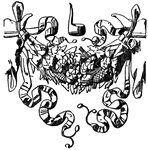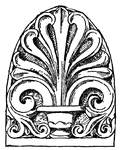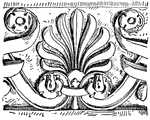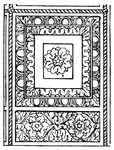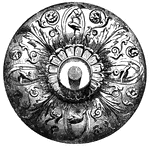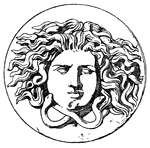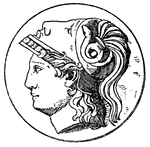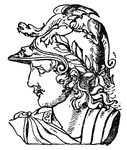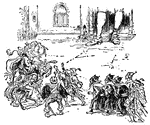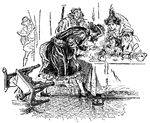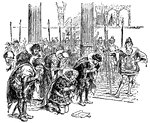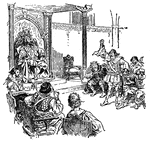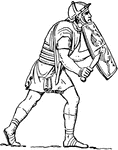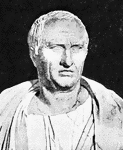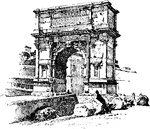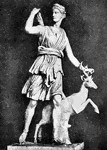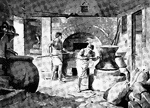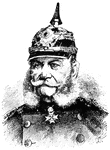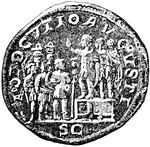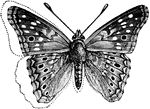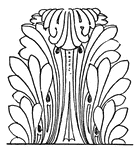
Acanthus Leaves
The Roman acanthus constitutes a type, rather than a particular form of leaf. As compared with the Greek…
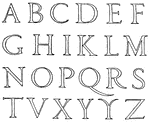
Roman Renaissance Alphabet
Roman Renaissance uppercase alphabet, 1547, specimen beek of John of Yciar, Durango, Biscaya.

Roman Renaissance Alphabet
Roman Renaissance lowercase alphabet, 1553, specimen book of Wolfgang Fugger, Nurenberg.

Steamer Alabama
"The Confederate privateer steamer Alabama (290). Captain Raphael Semmes. Our illustration…

Giant Kneeling Down
Gulliver kneeling down infront of the Lilliputian Emperor being condemned for a crime.

Representation of 1775
Virtual representation, 1775. 1. One String Jack, Deliver your property. 2. Begar, just so in France.…

Walnut Street Prison
"The Walnut Street Prison. This edifice was erected in 1774, and taken down in 1836. The beautiful new…
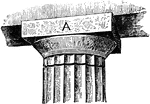
Abacus
"In architecture the slab or plinth which forms the upper member of the capital of a column or pillar,…
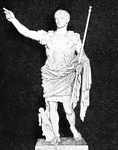
Augustus
"Augustus ruled for about forty-two yeras, that is, from 27 B.C. to 14 A.D., and this period is known…
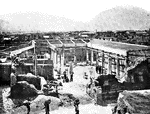
Pompeii
"Excavating a house at Pompeii from eruption of Vesuvius, which buried the cities of Herculaneum and…
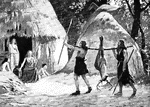
Germans
"Early Germans. These German ancestors of ours, for so we must consider them, since the chief element…
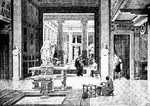
House
"A Roman house. In early times the private houses of the Romans were very simple, showing little attempt…
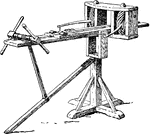
Catapult
"Catapult from the Roman military system. The Roman army was divided into legions, each of which contained…

Martin Luther
"Martin Luther was born at Eisleben in 1483. He was the son of a poor miner, had entered the Augustinian…
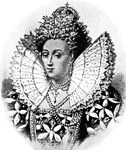
Queen Elizabeth
"Queen Elizabeth was the daughter of Henry VIII, by Anne Boleyn. Her reign is one of the most remarkable…

Gustavus Adolphus
"Gustavus Adolphus entered Germany at the head of 16,000 men. Among some of the Protestants there was…

Acanthus
"A genus of small herbaceous plants of southern Europe and Africa; they have spinosely toothed leaves,…
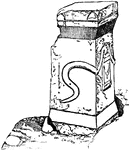
Greek Altar
"Round, triangular, or square in plan, often elaborately adorned with sculpture, and bearing inscriptions."-Whitney,…

Amphora
"A jar with two handles; Among the Greek and Roman, a vessel, usually tall and slender having two handles…

Amphora
"A jar with two handles; Among the Greek and Roman, a vessel, usually tall and slender having two handles…

Chrysalis of the Luna Moth
"Among the larger and more splendid moths of our own country is the Luna Moth, or Green Emperor Moth,…
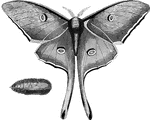
Luna Moth
"Among the larger and more splendid moths of our own country is the Luna Moth, or Green Emperor Moth,…

Caterpillar of the Luna Moth
"Among the larger and more splendid moths of our own country is the Luna Moth, or Green Emperor Moth,…

Hall in Baths of Caracalla
"Marcus Aurelius Antoninus Caracalla was eldest son of the Emperor Severus, born in Lyons, A.D. 188.…
